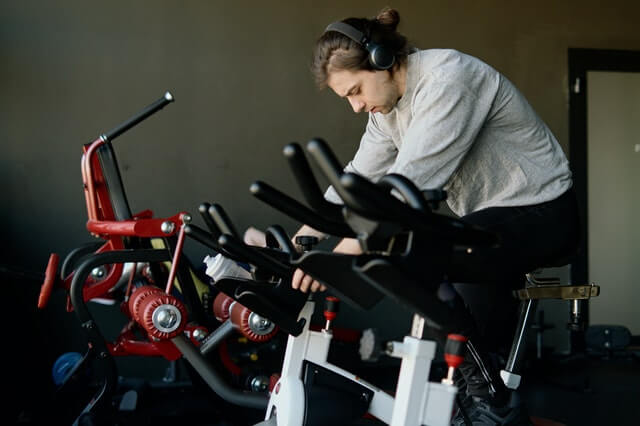Cardio and strength training both rightly have enthusiastic fans. When used correctly, both can have a positive effect, for example on our cardiovascular system, our muscles and our posture. This raises many questions. Should I do both cardio and strength exercises? If so, in what order and how often and for how long? We will get to the bottom of these questions in the following article.
Cardio and Strength Training: An Overview
Cardio sport involves endurance training using targeted exercises carried out freely or on equipment. The name is derived from the word cardiovascular. We also know the cardiovascular system as the cardiovascular system. Accordingly, cardio training stands for various exercises that challenge this.
With cardio sessions you train larger muscle groups , which increases breathing, heart and pulse rates. They also stimulate metabolism and calorie consumption, thereby promoting fat burning. We increase our oxygen intake for the brain and body.
Cardio training also helps reduce stress and aims to lower our blood pressure in the long term. We are able to increase our general resilience and improve our physical condition. This can even have a preventative effect on illness.
How our body reacts to the endurance sessions depends on the exercise sequences and the associated stress. For example, like with strength training, legs or arms can be targeted specifically. It also depends on the method chosen.

There is, among other things, the permanent method. With this, you constantly expose your body to a certain amount of stress over a longer period of time. If, on the other hand, you decide on an interval method, you alternate stress and relaxation . It is possible to vary both methods individually.
Strength training, like cardio sports, can be carried out either on and with equipment or freely. The latter falls under the term bodyweight training. This summarizes all exercises that work with your own body weight and the resulting resistance. Strength training specifically targets our muscles and helps build muscle . We also train the supporting tissue of our body, especially tendons, ligaments and our bones.
Thanks to improved posture, we work preventatively against falls and injuries. Interesting for those who want to lose weight : We increase our basal metabolic rate with strength training or trained muscles. This is the energy requirement that our body has when resting. Strength training therefore ensures higher calorie burning in the long term.
How can you combine cardio and strength training?
Why limit yourself when you can have endurance and strong and defined muscles at the same time? That's right, a mix of cardio and strength training is the best way to exercise. However, the focus is on setting individual priorities. Because we all have different training goals, which is why there are different training paths .
Now the question inevitably arises as to how such a training path can be designed. The main thing is the intensity and sequence of the training. There are no scientifically based standard answers in this regard. Accordingly, there are different opinions and recommendations. As always, individual factors such as training goals and fitness level decide.
A sensible recommendation, for example, is to align the order according to the training focus. What is more important to you, endurance or strength ? Start with your preference. Then you still have all your energy reserves available and you can give your all during training.

Don't forget to plan breaks and regeneration periods . This is especially true if you are not yet a “ sports buff ” and are more of a beginner. A break of one to two days between training sessions results in a good workload.
Are you already quite fit or are you less flexible in terms of time? Then at least make sure to give individual parts of your body rest every now and then. Because when it comes to training, it's not just about what, but above all about how. For example, if you train your legs during strength training, you will have problems properly carrying out a cardio workout that focuses on your legs .
Training duration and frequency: Get recommendations
As already mentioned, individual factors determine the duration and frequency of training. Age, fitness level, general health and training goals are taken into account in training plans . In order to do this better, it always makes sense to seek advice from doctors or other fitness and health experts.
For example, carry out a stress test at your family doctor. This way you can determine your fitness level and create a training plan based on it. For example, the World Health Organization (WHO) recommends 150 to 300 minutes of moderate to vigorous intensity endurance activity per week . An alternative is 75 to 150 minutes of intensive exercise.
This recommendation is aimed at adults aged 18 to 64 . As a supplement, moderate-intensity strength training should be carried out two days per week in order to target all important muscle groups.
Lose weight with cardio or is it better to do weight training?
Because it burns calories, cardio training has long been considered a kind of " cure-all " for losing weight. However, knowledge has changed in this area.
The success of cardio training does not only depend on our training ambition or the intensity of the training. Factors such as our body weight or our general physical fitness are also important.
This results in the actual calorie burn during a training session. Of course, other lifestyle habits also play a big role when it comes to how much you can lose weight with cardio .
A direct comparison shows that strength training burns fewer calories . However, muscle training has a so-called “ afterburn effect ”. It also increases our body's resting energy requirements (basal metabolic rate). Strength training also benefits us when it comes to losing weight.

What else is important when it comes to endurance and strength sessions?
Every training session puts a strain on your body. Therefore, in addition to the actual training, preparation and follow-up are also important. Perform warm-up exercises before strength training or cardio sessions . Such a warm-up prepares your cardiovascular system and muscles for the upcoming training.
There are a variety of warm-up exercises available for cardio training.
These include, for example:
- (varying) running on the spot
- Jump rope
- Jumping jacks, also known as jumping jacks
- Mountain Climber: alternating bending of the legs from the push-up position
- Burpees: a flowing sequence of movements consisting of squats, push-ups and stretch jumps
The warm-up exercises for strength training can be designed similarly to those before cardio sessions . You are free to do them with or without aids such as devices.
For example, the following are possible:
- Walking or jogging, for example on the treadmill
- Warm up on the cross trainer, rowing machine or bike
- dynamic stretching
Since you specifically target specific muscle groups with strength exercises , you should do the same with warm-up exercises. A mixture of warm-up for the whole body and specific warm-up is recommended.
After completing a training session, you should slowly “ shut down ” your body. Stretching after strength training or cardio intervals is just as much a part of sport as warm-up. Stretching serves to relax the muscles and their surrounding tissue after strain.
Static stretching exercises are suitable for this. When stretching after strength training and endurance sessions, pay particular attention to the body regions or muscle parts that are stressed during training.

Endurance and strength training at home or better in the gym?
Carrying out cardio sessions or strength training without or with equipment is particularly a matter of personal preference. The same applies to the choice of whether you prefer to do both in the gym, outdoors or at home. Cardio exercise or strength training at home can definitely be designed effectively and tailored to the respective training goals.
Whether cardio or strength training without equipment or with , an individual training effort and correct execution are important.
How can your sports sessions be sensibly supplemented with cardio and strength training?
When it comes to all questions about exercise, you should not neglect the topic of “ fuel ,” i.e. nutrition. Our body needs the right supply of nutrients, especially during active sports.
This includes, among other things , taking amino acids . They are the smallest component of proteins. These are part of our organs and, as enzymes, control our metabolism .
Essential amino acids are those that our body does not produce itself. So we need to absorb them so that the proteins can function properly.
Otherwise, potential risks arise such as:
- a weakened immune system: resulting in susceptibility to infections
- general decline in performance
- Problems building muscle
- Complaints with the joints
- Metabolism disorders: promotes further effects such as weight gain despite exercise
An amino acid analysis (the aminogram ) at the doctor will give you information about how your health is going.




